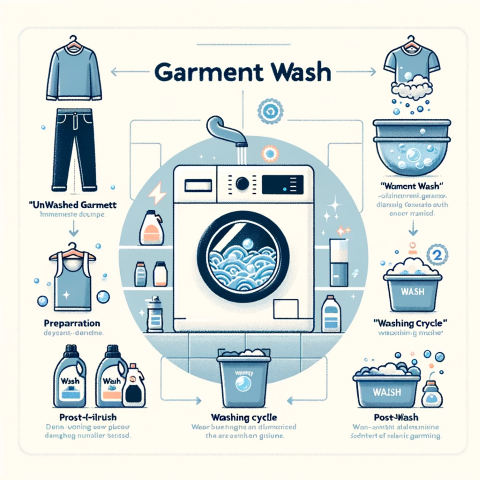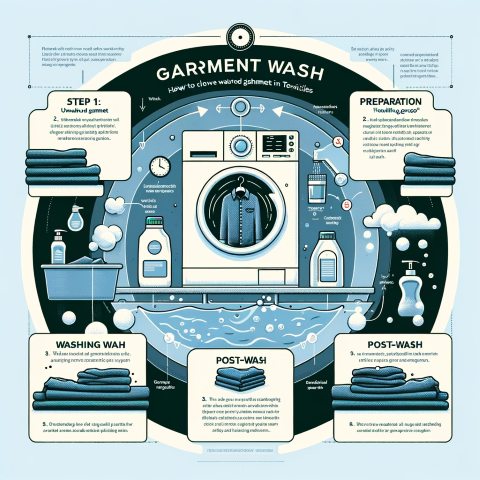Last Updated on: 19-Feb-2024 (5 months, 8 days ago)
Share on Facebook • Share on Twitter
Garment Wash Techniques: The 1960s Denim Revolution Revisited
Garment Wash is a textile finishing process that involves washing and treating garments to achieve specific aesthetic and functional effects. It is a crucial step in the production of various types of apparel, ranging from denim jeans to casual wear. This comprehensive article provides a detailed understanding of Garment Wash, including its history, types, tips for handling, and profiles of top international users and manufacturers.
The practice of Garment Wash dates back to the late 1960s when denim jeans gained popularity as a fashion statement. The desire for a worn-out, distressed appearance led to the development of various washing techniques to achieve this effect. Initially, manual processes such as stone-washing and sandblasting were employed. However, environmental concerns and worker safety issues led to the adoption of more sustainable and safer methods in the subsequent decades.
Garment Wash encompasses a range of techniques, each resulting in different effects. Some commonly used types of Garment Wash include:
- Stone-Washing: Involves tumbling garments with pumice stones or enzymes to achieve a faded, worn-in appearance. This process softens the fabric and creates a distressed look.
- Enzyme Wash: Utilizes enzymes to break down the indigo dye in denim or other pigments, resulting in a faded or vintage look.
- Acid Wash: Involves treating denim garments with a strong acid to remove the top layer of color, resulting in a mottled or bleached effect.
- Bleach Wash: Uses bleach or chlorine-based chemicals to lighten the fabric, creating a desired level of fading or discoloration.
- Over-Dyeing: Involves dyeing pre-washed garments with a different color to create unique hues and tones.
Tips for Handling Garment Washed Apparel
Proper care and handling are essential to maintain the appearance and longevity of garments that have undergone Garment Wash. Here are some tips:
- Follow Care Instructions: Always refer to the garment's care label for specific washing and drying instructions.
- Wash Separately: Garment washed apparel may bleed or transfer color, so it's advisable to wash them separately or with similar colors.
- Gentle Wash Cycle: Use a gentle or delicate wash cycle to minimize abrasion and protect the garment's texture and color.
- Avoid Harsh Detergents: Use mild, pH-neutral detergents to prevent damage to the fabric and preserve the garment's appearance.
- Air Dry or Tumble Dry Low: To prevent excessive shrinkage or damage, it is recommended to air dry garments or tumble dry them on a low heat setting.
Top International Users and Manufacturers
Several renowned international brands are recognized for their expertise in utilizing Garment Wash techniques to enhance the appearance and quality of their apparel. Here are some of the top users and manufacturers:
- Levi's: Levi's, the iconic denim brand, is known for its expertise in garment washing. Their extensive range of denim jeans showcases various wash effects, including stone-washing, acid wash, and vintage-inspired finishes.
- GAP: GAP, a global fashion retailer, incorporates Garment Wash techniques in their denim collections, offering a wide array of washes and finishes that cater to diverse consumer preferences.
- Zara: Zara, a popular fast-fashion brand, utilizes Garment Wash to create unique finishes in their denim and casual wear collections, providing customers with trendy and fashion-forward designs.
- H&M: H&M employs Garment Wash techniques to enhance the appearance and comfort of their denim and casual wear garments, delivering affordable fashion with a focus on sustainability.
- Abercrombie & Fitch: Abercrombie & Fitch incorporates Garment Wash processes to achieve the desired worn-in and vintage aesthetics in their denim and casual clothing lines.
- Wrangler: Wrangler, a prominent denim brand, uses Garment Wash techniques to produce a wide range of finishes, from classic indigo washes to rugged and distressed looks.
Garment Wash plays a crucial role in the textile industry, enabling manufacturers to achieve desired aesthetic effects and improve the overall quality and appeal of apparel. With a rich history and a wide range of techniques, Garment Wash offers endless possibilities for creating unique finishes and styles. By understanding the various types of Garment Wash and following proper care instructions, consumers can enjoy garments that showcase the desired appearance and longevity, while international brands continue to innovate and push the boundaries of garment washing techniques.
A wash process where softeners are added to finished garments to help the cotton fibers relax or bloom. The result is a fabric with a thicker appearance, reduced shrinkage and a softer hand.
Some more terms:
Bulking
A technique of altering yarns to make them fluff, curl, or crimp up to give them a bulked appearance. High bulk yarns are sometimes made by combining high shrinkage staple components with low...
Read about BulkingFlocking
A type of raised decoration applied to the surface of a fabric in which an adhesive is printed on the fabric in a specific pattern, and then finely chopped fibers are applied by means of dusting,...
Read about FlockingDouble Weave
A woven fabric construction made by interlacing two or more sets of warp yarns with two or more sets of filling yarns. The most common double weave fabrics are made using a total of either four or...
Read about Double WeaveDecal Comanie
An old form of lithographic printing, for embroidery transfers. The design was transferred from the tissue paper on which it was printed, usually by ironing. Thick enamel-like pigments were employed...
Read about Decal ComanieDoupion
(douppioni) silk yarns made from the cocoon of two silk worms that have nested toghether. In spinning, the double strand is not separated so the yarn is uneven and irregular with a large diameter in...
Read about DoupionBi-Swing Back
In textiles, a bi-swing back refers to a design element that is commonly used in jackets and other types of outerwear. It is a type of back construction that features a seam that runs horizontally...
Read about Bi-Swing BackHydrophilic Fibers: Enhance Moisture Management in Athletic Wear
Hydrophilic fibers refer to fibers that can absorb moisture and water, making them useful for textiles that require moisture management, such as athletic and performance wear. Hydrophilic fibers can...
Read about Hydrophilic FibersEpingle fabric
A type of velvet fabric woven on a wire loom or ?pingl? loom. The ?pingl? velvet is specific by the fact that both loop pile and cut pile can be integrated into the same fabric. The art of ?pingl?...
Read about Epingle fabricOn this page
Add a definition
- The term you want to define
- Its definition in 500 words or less
- Attach an image if necessary.
- Optionally, tell us about yourself in 200 words or less!
Companies for Garment Washed:
- Company name
- Company address
- Attach a logo, if necessary.
- Optionally, tell us about yourself in 200 words or less!

 The textile industry in Bangladesh employs over 4 million people.
The textile industry in Bangladesh employs over 4 million people.

